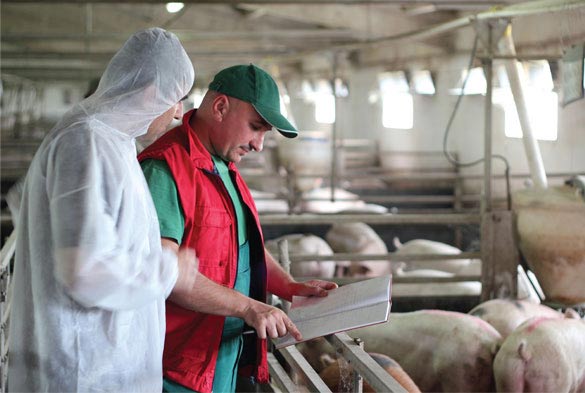After porcine epidemic diarrhea, preparing for other diseases
Some of tomorrow’s emerging pathogens already exist in livestock herds somewhere, Dr. Robert Desrosiers said.
He cited the history of porcine reproductive and respiratory syndrome, first characterized as “mystery swine disease” in 1987. A retrospective study of samples from the U.S. and Canada, however, found pigs had antibodies against the virus’s precursor as early as the late 1970s.
And, certain pathogens, such as swine influenza virus strains, have the potential to result in disastrous consequences if their adaptations cause substantial harm to humans.

Dr. Elizabeth Lautner, associate deputy administrator of science, technology, and analysis services for Veterinary Services in the Department of Agriculture’s Animal and Plant Health Inspection Service, said the emergence of PRRS in pigs and of severe acute respiratory syndrome in humans also show that disease emergence is unpredictable.
Drs. Desrosiers and Lautner were among lecturers on disease risk, preparation, and response during the American Association of Swine Veterinarians meeting Feb. 28-March 3 in Orlando, Florida. The meeting occurred almost two years after the emergence in the U.S. of coronavirus strains that cause porcine epidemic diarrhea, which another presenter indicated has killed at least 8 million pigs in the U.S. alone.
The first U.S. outbreaks of PED were identified in April 2013. Researchers found a separate porcine deltacoronavirus in early 2014, and that virus has been associated with clinical signs similar to those of PED and transmissible gastroenteritis but with lower death rates than those for PED.
Preparing for the unpredictable
Dr. Patrick M. Webb, director of swine health programs for the National Pork Board, said wider use of premise identification numbers as a routine part of swine industry practices, such as in animal movement records and submission forms for diagnostic laboratories, would help during future animal disease outbreaks. That movement and diagnostic test information could be used by industry and animal health officials such as state veterinarians to understand the size of disease outbreaks and make decisions in response.

Dr. Max T. Rodibaugh of Swine Health Services in Frankfort, Indiana, said veterinarians need to work with pig owners to ensure they share information that could aid responses to the next disease outbreak. He also encouraged veterinarians to see their patients in person inside barns, rather than by photos, and collect samples when they encounter unusual signs.
Dr. Rodibaugh also suggested veterinarians avoid obsessing over small details on certain aspects of production so as not to risk missing more obvious problems in others. For example, he noted that he knew of a company that was washing trucks with recycled wash water, which could spread contamination among trucks.
Dr. Lautner said in her presentation and wrote in the conference proceedings that APHIS Veterinary Services will implement—as a core business—a series of plans published in 2014 on identifying, evaluating, and responding to emerging disease. Those plans involve watching and preparing for animal diseases or pathogens outside the U.S., identifying and understanding disease events, describing findings to those affected, and minimizing disease impact.
APHIS officials described the plans in the 2014 document “Veterinary Services Proposed Framework for Response to Emerging Animal Diseases in the United States.”
The agency also has proposed requiring reports on any possible or confirmed instances of diseases on a new National List of Reportable Animal Diseases as well as requiring reports on diagnosed or suspected cases of any other animal disease not known to exist in the U.S. Veterinary Services published the proposals in October 2014, accepted comments through January 2015, and planned to propose regulations after reviewing comments.

The AASV, National Pork Producers Council, and National Pork Board also have worked to establish the Swine Health Information Center, an organization the sponsors hope will help the U.S. swine industry prepare for disease challenges, particularly by filling resource and knowledge gaps in diagnostics for emerging diseases. It has $15 million to fund operations for the next five years, with the money coming from the industry-funded Pork Checkoff program, according to an NPB announcement from November 2014.
Persistent vulnerability
North America is “in a state of persistent vulnerability,” Dr. Desrosiers said, and it is a danger to others. He cited reports that North American PRRS virus strains were introduced to China during the mid-1990s and that PED virus strains in South Korea and Taiwan may have originated in the U.S.
Dr. Desrosiers said veterinarians and other animal health authorities are unlikely to prevent outbreaks when once-harmless organisms in domestic livestock become pathogens, but precautions such as maintaining minimum distances between farms, keeping herds closed to outside animals, and breeding for more robust animals could reduce harms.
As for known diseases present elsewhere, countries can work to prevent introduction by enacting trade restrictions or by ensuring imports are free from pathogens. He said the latter would be more complicated but more accepted by trade partners.
And, in response to pathogens spread mostly through fomites and other indirect transmission means—as happens with the PED, PRRS, and foot-and-mouth disease viruses—Dr. Desrosiers said cooperation and coordinated responses would provide better results than individual efforts alone.
Related JAVMA content:
PED virus reinfecting U.S. herds (July 15, 2014)
Considering risks after colleagues’ battle (June 1 ,2014)
More virus strains found in pigs (April 1, 2014)
Fighting a deadly pig disease (Aug. 15, 2013)